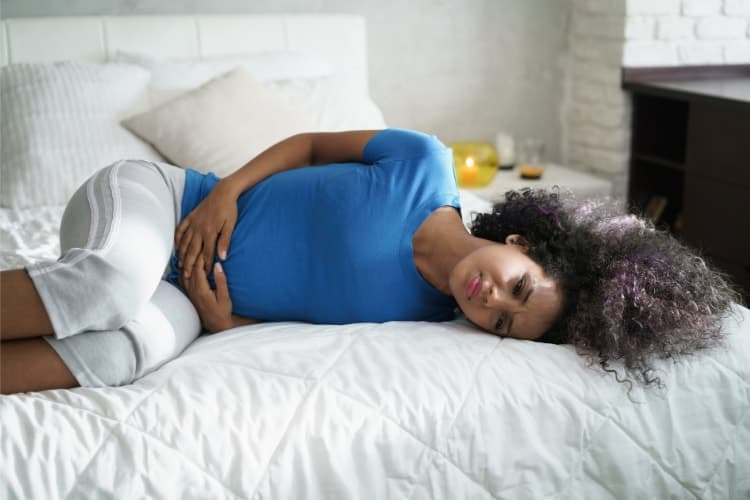
Having your period can be exhausting – even more so when you’re struggling to figure out how to sleep with menstrual cramps.
But have no worries because there are several natural – and effective – options that can help you sleep better even when menstrual pain (aka dysmenorrhea) kicks in.
In this simple guide you will get the scoop on:
- How the menstrual cycle affects your ability to get high quality sleep.
- Why cramps tend to get worse at night.
- 10 things that can help you catch those zzz’s during your cycle.
DO YOU SLEEP WORSE ON YOUR PERIOD?
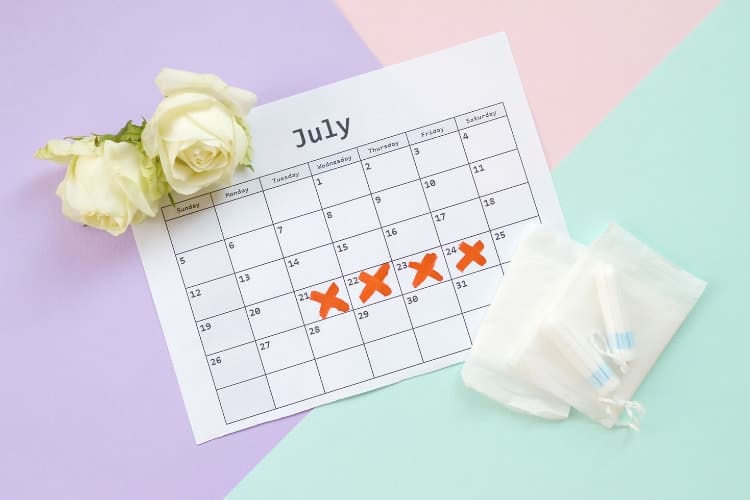
In order to understand how the menstrual cycle affects sleep, it’s key to first understand that there are two types of sleep:
- REM (rapid eye movement) sleep.
- non-REM sleep.
We go through both types of sleep several times throughout the night. And as we get closer to morning, we get longer and deeper periods of REM sleep.
At a more granular level, the different stages of REM and non-REM sleep can be broken down into (source):
- Stage 1: This is non-REM sleep and it’s a light phase of sleep as you make the transition from being awake to falling asleep.
- Stage 2: This is also non-REM sleep and this is when your body is preparing to enter deep sleep. During this phase your body temperature drops, heart rate slows down and your muscles begin to relax.
- Stage 3: This stage brings deep sleep, and this is the phase that is critical to you actually feeling rested and refreshed in the morning.
- REM Sleep: This phase occurs approximately 90 minutes after you fall asleep. Most dreaming happens in this stage, and your brain wave patterns become similar to when you’re awake.
So, how does all of this change when you’re on your cycle? Well, some studies indicate that (1, 2):
- The quality of stage 2 and REM sleep changes when we’re menstruating.
- It can take longer to fall asleep during the luteal phase of the menstrual cycle. In addition, there’s a marked reduction in sleep quality during the luteal phase.
So, as you can see, the menstrual cycle can affect various aspects of our sleep.
Now, what happens when we add dysmenorrhea (aka intense period cramps) to the mix? It can create more sleep disruption because cramps come with underlying hormonal imbalances.
Let’s have a closer look now at some of those imbalances.
TOP REASONS WHY YOU CAN’T SLEEP WITH PERIOD PAIN (AND WHY IT’S WORSE AT NIGHT)
The most important reason why sleep is more difficult with period pain is increased inflammation and cortisol.
You see, cramps are triggered by inflammation. And the inflammation itself results from elevated levels of prostaglandins (a hormone) that are made in the uterus (source).
Now, the main issue here is that when inflammation is high, cortisol is also high. You see, cortisol is the body’s natural anti-inflammatory hormone. The two go together like humans and oxygen!
Unfortunately, chronically elevated levels of pain and cortisol are recipe for disaster because it’s impossible to relax when you’re in physical pain and high cortisol makes it very difficult to fall asleep.
In fact, there’s a variety of research that demonstrates the strong connection between cortisol, sleep and our circadian rhythm or internal clock (3, 4, 5).
In addition, it’s also important to note that as inflammation and cortisol increase, fluctuations can also occur in other hormones (like estrogen and progesterone).
So, when you put all of this together it’s no surprise that deep, restful sleep can be hard to come by when you have a painful period.
Furthermore, there are a few other factors that can make cramps worse, particularly at night. Here’s a quick overview of those factors.
1. Pressure on the abdominal muscles
Lying on your stomach or your back can put pressure on your abdominal muscles and make cramps feel more intense. And sleeping on your stomach, in particular, can add pressure to the uterus. Not only does that mean more pain, but potentially, more bleeding.
2. Dehydration
Drinking water is essential for ensuring that our metabolic processes – such as hormone production, waste elimination, falling asleep, energy regulation, etc. – function properly.
However, if you’re not drinking enough water, or you’re not eating plenty of water-rich foods or you’re drinking too much caffeine, you can end up being dehydrated by the end of the day.
And that dehydration can make pain feel worse, which will further disrupt your sleep.
3. Increased perception of pain
During the day, we’re usually so busy that we’re distracted from the full intensity of cramps.
However, once you lie down in bed and there’s nothing to do, that pain has your full attention. And the more we notice it, the harder it is to un-notice it…and that makes falling asleep that much harder.
Furthermore, there’s also the fact that the less sleep you get, the lower your tolerance for pain (source)! Talk about a vicious cycle!
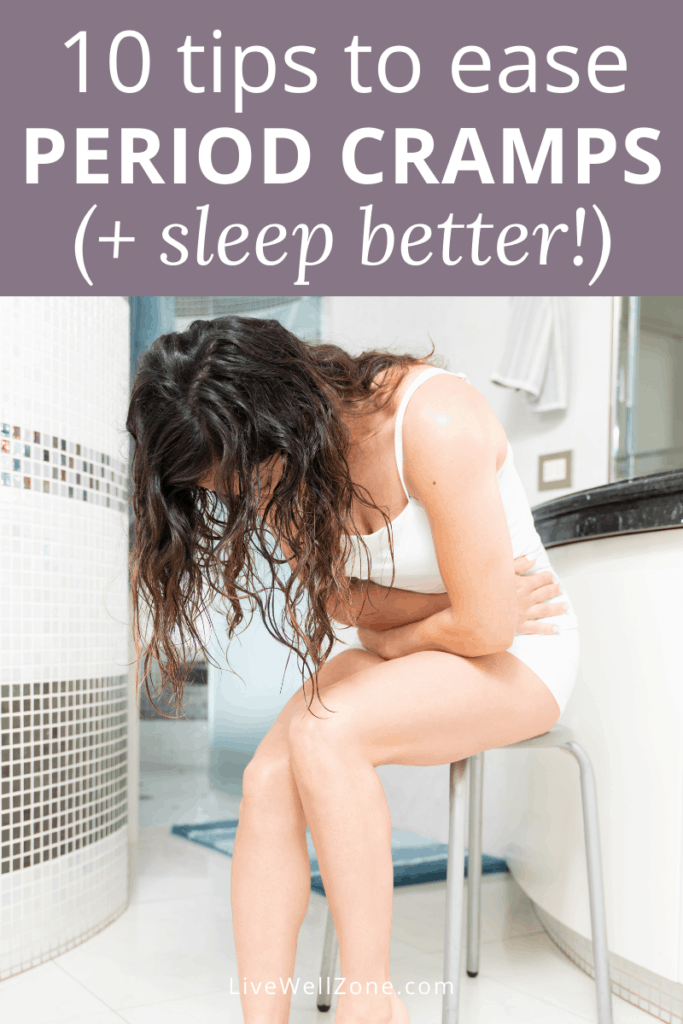
WHAT IS THE BEST POSITION TO SLEEP ON YOUR PERIOD?
Given that laying on your stomach or back leads to more pressure on the abdominal muscles, the best sleeping position during your period is on your side.
Lying on your side allows your abdominal muscles to relax and be less tense. With less tension, there’s also less cramping.
10 MORE WAYS TO GET BETTER SLEEP WITH MENSTRUAL CRAMPS
The tips below will help give you temporary relief from period cramps and help you feel more relaxed so that you can fall asleep.
Regular incorporation of many of these tips (especially the dietary ones) will also address chronic inflammation so that you can say goodbye to cramps for good!
1. Practice Yoga
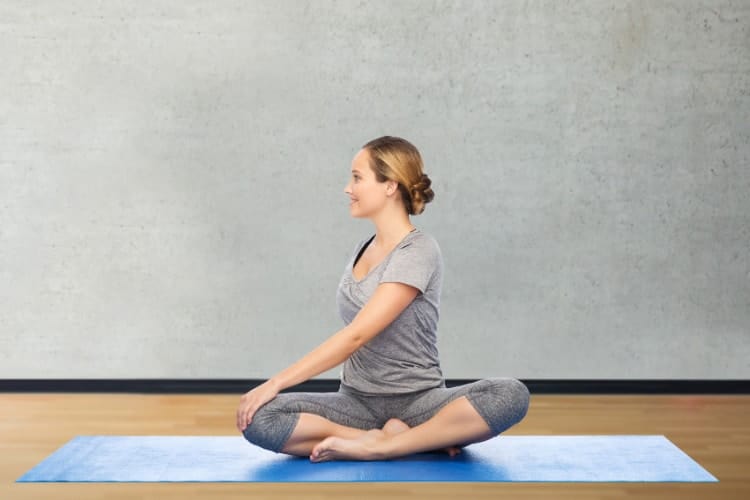
A review of 15 studies on yoga and the menstrual cycle showed that yoga reduces the severity of symptoms like (source):
- Menstrual pain.
- Bloating.
- Breast tenderness.
- Mood swings.
In addition, yoga was also found to improve menstrual regularity, concentration and the overall sense of relaxation.
2. Sip on Soothing Turmeric Milk
Turmeric is a powerful anti-inflammatory herb that is helpful for protecting liver health.
And this is important for relieving menstrual cramps because the liver filters out toxins that can contribute to hormonal imbalance and inflammation.
To get the most out of turmeric, I suggest drinking it in the form of turmeric milk (aka golden milk). Although you can drink it at any time of the day, it’s especially soothing at night, about an hour before bedtime.
In this post on how to use turmeric for hormonal imbalance, there’s a turmeric milk recipe that you can use. It also contains ginger and cinnamon…all powerful ingredients for combating inflammation!
3. Soak In An Epsom Salt Bath
When you’re feeling drained and worn out from menstrual pain, an epsom salt bath can help you unwind, while also relieving pain.
The main reason why epsom salt is beneficial is it’s magnesium content, which is an anti-inflammatory nutrient (source).
One thing to note: be sure not to make your bath too hot, because your body temperature is already slightly higher during your cycle. If the bath is too hot, that can raise your body temperature even more and interfere with your sleep.
4. Try Some Pranayama
Pranayama is the general name for various types of breathing exercises that are part of the yogic tradition.
Simply doing pranayama (even without doing yoga poses) can reduce pain and cortisol levels (i.e. cool down that inflammatory fire).
The two that are most helpful during the menstrual cycle are nadi shodana (alternate nostril breathing) and ujjayi breathing.
Here’s a simple demo of how to do alternate nostril breathing:
As for ujjayi, here’s a fantastic, easy-to-follow tutorial:
5. Enjoy A Pain-Relieving Smoothie
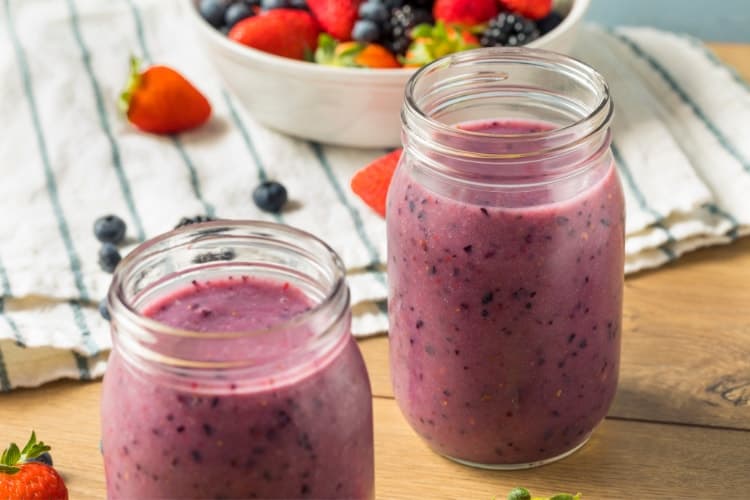
With the right combination of ingredients, a smoothie can help you lower systemic inflammation, get rid of hormone-disrupting toxins and reduce the intensity of pain.
Oh and let’s not forget that smoothies help you stay hydrated which, as we saw earlier, supports your entire body in functioning better.
Now, as far as what to include in your smoothie – fruits, veggies, seeds, and more – be sure to read this post on how to make the best smoothie for period cramps.
6. Reach for Anti Inflammatory Foods
Since we’ve talked about inflammation a zillion times during this article, it’s no surprise that eating more anti-inflammatory foods can help ease cramps and improve sleep.
Please keep in mind that inflammation isn’t just about pain. It’s also a major contributing factor to all types of hormonal imbalances.
And both cramps and sleep are affected by hormones such as prostaglandins, cortisol and melatonin. So, to keep these hormones in check, we need those anti-inflammatory foods.
For specifics on which anti-inflammatory foods to focus on – as well as some bonus recipes you can download – check out my hormone balancing diet plan.
7. Use Essential Oils For Menstrual Pain Relief
Remember that whole thing about inflammation and cortisol increase together? Well, it turns out that simply inhaling clary sage essential oil can reduce cortisol levels by up to 36% (source)!
But you don’t just have to stop at inhaling essential oils. You can also do an essential oil massage with clary sage and other pain-busting oils like peppermint, frankincense, ginger or copaiba oil.
To learn how to use these oils safely, plus tips on how to make your own blend and which and which store-bought blend to buy, I recommend reading this post on essential oil roller blends for menstrual cramps.
8. Use a Heating Pad To Ease Period Pain
For quick and immediate relief from period pain, reach for a heating pad. This natural remedy provides relief because heat increases blood flow to the site of pain and therefore, helps your muscles (i.e. uterine muscles) to relax (source).
For the best results, apply the heating pad to the lower abdominal area and/or lower back.
Hint: massage essential oils onto your skin first, then apply a heating pad. The heat can help you absorb more of those pain-fighting, hormone-balancing oils.
To learn more about how heat therapy helps cramps, plus how to get the most out of it, read this post on heating pads for menstrual cramps.
9. Break A Sweat With Some Cardio Exercise
Doing a cardio workout is a great way to release endorphins, which are feel-good hormones that lower pain and stress (source).
Just be careful not to work out too close to bedtime, because intense exercise raises body temperature and increases energy levels. This can end up keeping you up at night.
So, if you’re going to do cardio, give yourself a few hours (say 4) before heading to bed.
10. Increase Your Zinc Intake
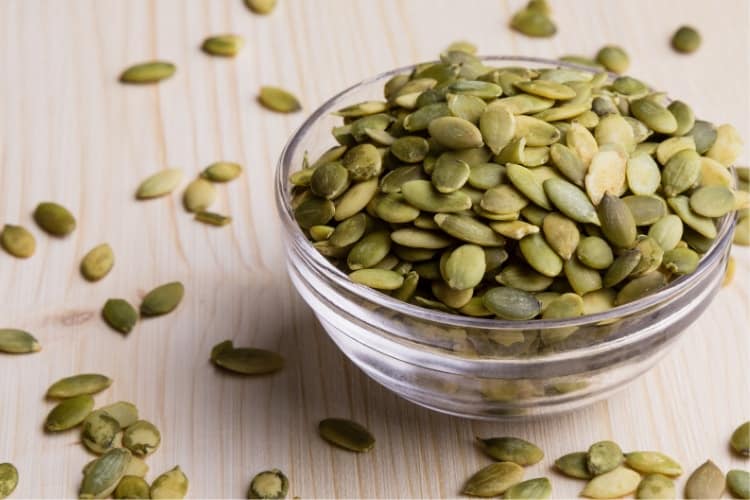
Research shows that taking 30mg of zinc, to 3 times a day and 1 to 4 days before the start of the menstrual cycle , can prevent cramping and other premenstrual symptoms (source).
And aside from taking zinc supplements, you can also try seed cycling. Seed cycling is a simple dietary approach to supporting the menstrual cycle and your hormones as a whole.
Seed cycling can help with everything from cramps and acne, to mood swings and improved fertility. All you have to do is eat more seeds like pumpkin and flax (which are both full of zinc!).
For the full details on how to seed cycle, read this beginner’s guide to seed cycling for hormone balance.
RELATED QUESTIONS
Why do I only get period pain on one side?
If you have pain on one side of your abdomen during your period, it could be related to an ovarian torsion. This occurs when the ovary becomes twisted and blood supply to the ovaries is cut off (source).
An ovarian torsion is a very serious situation that can permanently affect ovarian function. If you suspect that this is the cause of your cramps, it’s important to seek medical attention immediately.
Do period cramps get worse with age?
It’s possible for cramps to get worse with age, particularly during perimenopause. However, there’s also medical literature confirming that women in perimenopause actually have elevated estrogen levels and lower progesterone (source). That combo can create a state of estrogen dominance, which contributes to cramps.
In many cases, this imbalance can be improved through diet and lifestyle as discussed in this post on how to eliminate estrogen dominance naturally.
CONCLUSION
Even though menstrual cramps are very common, they’re not “normal” and they don’t have to ruin your sleep (or quality of life).
I hope that the tips provided in this article help you get the relief and sleep that you deserve.
Related Posts:
3 Quick and Easy Ways To Use Cloves For Menstrual Cramps
Why You Need Chamomile for Period Pain & PMS (and How to Use It)
Home Remedies For Menstrual Cramps: 7 Tips You Probably Don’t Know About (That Actually Work!)
4 Things You Should Know About Protein Powder and Your Menstrual Cycle
3 Reasons To Use Blackstrap Molasses for Heavy Periods
10 Best Teas for Menstrual Cramps
5 Essential Oils for Heavy Periods That Provide Real Relief


